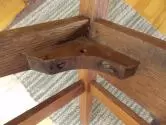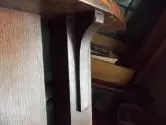Is it Really “Unsigned”?

A few months ago I was in Salt Lake City on business, but also took the opportunity to spend some time with my oldest son Eric, who is nearing completion of his doctorate in chemistry at the University of Utah. He and I took one of our regular jaunts over to the Salt Lake City Craftsman, an antiques warehouse operated by Riley Booker and his father Scott.
Salt Lake City has never been known as a hotbed of Arts and Crafts, but anyone who has read the reprint of Gustav Stickley’s 1912 furniture catalog would know that it was among the 50 cities listed as having a furniture store which carried Stickley’s line of Arts and Crafts furniture. As Gustav Stickley wrote in the 1912 catalog, “They carry such an assortment of Craftsman Furniture as to afford a satisfactory inspection, and will fill carefully any orders committed to them.”
A large percentage of Riley’s customers are relatively young collectors and homeowners, most new to the world of Arts and Crafts. Like so many cities across the country, Salt Lake City has several bungalow neighborhoods that have experienced a resurgence of interest, including their proper restoration and furnishing with both new and vintage Arts and Crafts pieces.

Not long ago Riley met a young couple who were drawn to a Stickley Brothers piece that had slipped out of the factory without a paper label or metal shopmark. It did, however, have a stenciled number on the back that corresponded with the identical piece illustrated in the reprint of one of the Stickley Brothers’ furniture catalogs. Riley showed them the catalog page, noted that the dimensions of the piece were the same as those listed beneath the picture, and pointed out the stenciled model number that also matched the catalog illustration.
But to them it was still “unsigned.”
They wanted a shopmark, not a stencil.
As I have often written, a shopmark should only confirm what the details have already told you. The shape of a corbel, the style of the hardware, the bevel of a post, the joinery of the boards, the size of the pegs, and, yes, even a stenciled model number on the back are as critical as any shopmark. Sure, we all love to see that faint red decal or even a scrap of a faded paper label, but the fact that a piece slipped out of the factory on Friday afternoon without a shopmark does not mean that it is should forever be deemed generic.
And, trust me, ask any advanced collector what some of their best discoveries were and chances are they were “unsigned.”
But they weren’t unsigned to them….
Whatever it is that you collect, make sure you have a reprint catalog that will enable you to be the one who identifies an “unsigned” piece. The late Stephen Gray, who founded Turn of the Century Editions, reprinted some of the first, and his mission has been carried forward with several more catalogs published by Janet and Peter Copeland, founders of The Parchment Press and now owners of Turn of the Century Editions.
You can see their ever-growing number of titles at:
http://www.turnofthecenturyeditions.com/
My advice: Don’t leave home without one.

Until next Monday,
“Get your happiness out of your work, or you will never know what happiness is.” – Elbert Hubbard
Bruce
PS – The couple did buy the Stickley Brothers piece of furniture.
To see Riley’s inventory at Salt Lake City Craftsman, go to:
http://www.webteek.com/saltlakecitycraftsman/
Top: The design of this corner bracket in a Gustav Stickley chair is as much his signature as his red decal.
Middle: A corbel beneath the arm of an L. & J.G. Stickley armchair. Study the details on a signed piece so that you can spot the unsigned example.
Have a comment, suggestion, or photo of your own? Jump over to our Facebook page, add it there, and see what others are saying.
